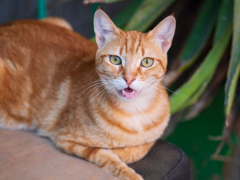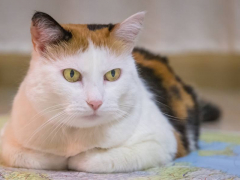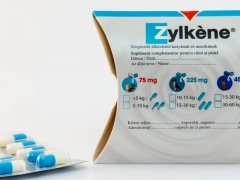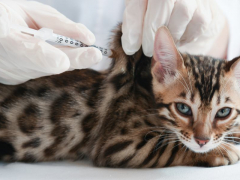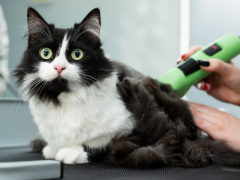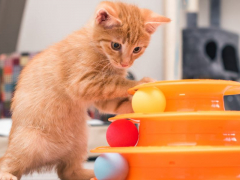
Cisapride is a promotility agent, or a medication that is used to encourage normal emptying and forward motion of digestive contents out of the stomach and through the gastrointestinal tract. It is a medication most often used to help cats with constipation or a medical condition called megacolon.
Cisapride For Cats Overview

In this article, you’ll learn more about how cisapride works, how it is prescribed, potential side effects, and some frequently asked questions.
About Cisapride for Cats
Cisapride is classified as a prokinetic or promotility agent. It is a serotonin (5-HT4)-receptor agonist, meaning it acts on serotonin receptors in the digestive tract. It stimulates smooth muscle contraction, which aids in emptying of the stomach and promoting motility of the small and large intestine.
What Does Cisapride Do for Cats?
Cisapride has been found to be useful in treating cats with recurrent constipation, and for cats with megacolon. Megacolon occurs when the nerves and muscles of the colon are no longer functioning normally.
This may occur secondary to something affecting the nerves primarily, or may be an effect seen in cats with chronic constipation or obstipation (a fecal obstruction) where the colon has been stretched to its limits so often that its muscular function is severely impaired.
By stimulating smooth muscle in the colon wall, cisapride helps the colon to move feces out and keeps it from backing up and leading to further constipation or obstipation.
Side Effects of Cisapride for Cats
Fortunately in cats, side effects appear to be few. Most common may be occasional vomiting, diarrhea, or abdominal cramping from the intestinal smooth muscle stimulation.
Because cisapride stimulates motility and pushes digestive contents along, it is extremely important that the medication is only used in the absence of a current obstruction.
For example, a cat with obstipation, or a fecal blockage, would need to have this resolved before starting cisapride. If a promotility agent is used when an obstruction is present, this may lead to worse adverse effects, and increased risk of intestinal perforation.
Cisapride should also be used cautiously in pets that also have liver disease, or any signs of bleeding from the digestive tract (either fresh blood or dark, tarry stool).
In people, cisapride was found to lead to a certain abnormal heart rhythm, or arrhythmia, prompting it to be removed as a drug for human use. This effect however, has not been documented in any veterinary medicine patients, including cats.
All the same, any cats with pre-existing heart disease may benefit from regular screening of their heart rate and rhythm while on cisapride.
Cisapride should be used very cautiously in pregnant or nursing queens.
Toxicity is uncommon when the medication is prescribed and used properly. The most common side effects reported from overdoses included diarrhea, lethargy, abnormal movements/imbalance, drooling, increased body temperature, and agitation.
Any concerns for an overdose of cisapride should be referred to a 24-hour veterinary poison consultation center, like ASPCA Animal Poison Control (1-888-426-4435) or the Pet Poison Helpline (1-855-764-7661). A fee does apply, but your vet will often need the toxicologist’s advice to help develop a treatment plan for your cat.
Lastly, cisapride can have drug interactions with several other types of medications. Always make sure to discuss any medications your cat is currently on with your vet before starting cisapride.
Cisapride for Cats Dosage

The dosage varies and depends on the condition and response, so talk to your veterinarian and follow his advice.
Cisapride is not a commercially available medication. Due to its concern for causing arrhythmias in people (which has not been shown to occur in animals), it was removed from the human market and is not available from human pharmacies.
Because it is not available commercially, cisapride can only be prescribed through a compounding pharmacy. The dosage varies and depends on the condition and response, so your veterinarian will be the best one to determine the correct starting dosage and how to adjust it.
Conclusion
Cisapride may be a helpful medication for some cats with constipation or megacolon. It is relatively safe to use in the right conditions and does not have the same concerning arrhythmia side effect in animals as seen in people.
However, because it is not commercially available and must be compounded, it can only be prescribed through an attending veterinarian familiar with a particular kitty’s condition.
Drug Dosing Disclaimer: We are only able to provide doses for medications that are FDA approved for use in cats and only as the label guidelines dictate. For medications that are used off-label we can only provide guidelines and safety information for use. Safe and appropriate dosing for off-label medications can only be determined by a primary care veterinarian.
We encourage you to work with your veterinarian to determine if a particular medication is appropriate for your cat. Changing or adjusting a dose for your cat on your own without consulting with a veterinarian can carry risk. We do not encourage use of medications prescribed for human use in pets without first consulting with a primary care veterinarian.
Frequently Asked Questions
How Long Does It Take Cisapride to Work in Cats?
Cisapride is a medication typically given every 12 hours in cats. Effects of the medication should be seen within this timeframe.
Why is Cisapride Banned?
In people, cisapride was found to cause a certain type of heart rhythm disorder, or arrhythmia, called QT-interval prolongation, and so it was removed as a commercially available medication. Otherwise, its side effects were found, even in people, to be fairly minimal.
This arrhythmia effect has not been documented in veterinary patients, and since it does appear to be very beneficial for cats with megacolon and some cases of constipation, it can still be prescribed through a veterinary compounding pharmacy.
When Can I Give My Cat Cisapride?
Only after discussing your cat’s condition with your veterinarian. It is most often used for cats with constipation or megacolon. However, not all cats with constipation need cisapride. Sometimes, certain laxative medications or a diet high in fiber is sufficient to manage constipation.
In cases of cats that get obstipated (fecal blockage) or have megacolon (where obstipation is common in untreated or poorly managed cases), a veterinarian must relieve any fecal impactions and ensure no obstruction of the GI tract is present before starting cisapride. A prokinetic/motility agent should never be used until the absence of GI obstruction has been confirmed.
How Much Cisapride Can You Give a Cat?
The dosage is very variable and depends on a cat’s particular condition and response. For example, a dose started initially may need to be gradually increased based on passage of stool. Because cisapride requires careful monitoring and because it can only be obtained through a compounding pharmacy, only your veterinarian most familiar with your cat’s condition will be able to provide proper dosing instructions.
